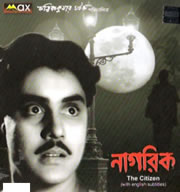Nagarik
Nagarik Bengali , also spelled as Nagorik, The Citizen in English, was the first featurelength film directed by Indian director Ritwik Ghatak. Completed in 1952, it preceded Satyajit Rays Pather Panchali as perhaps the first example of an art film in Bengali cinema, but is deprived of that honor, since it was released twentyfour years later, after Ghataks death. OnSeptember 1977, it finally premiered at the New Empire theatre in Kolkata, India. Ritwik Ghatak directed only eight feature films, but is generally regarded as one of the few truly original Indian talents in cinema by directors such as Satyajit Ray and critics such as Derek Malcolm.
Just before the family has to leave to go stay in slums, Ramu visits Uma and tells him they are moving. Uma offers to help them set up in the new dwelling, an obvious sign of humanism on Ghataks part. Shephali, her sister, cannot bear to live in poverty any longer, so she leaves home with a shady man. Seeta confesses that she loves Sagar, a love that Sagar reciprocates. However, Sagar, is now rendered homeless and destitute and mentions that he does not have the audacity to expect them to even be united. Ramu overhears parts of Sagar and Umas conversation and is touched by the moment. He appeals to Sagar for him to come and live with the family. The film ends with the characters walking out in the rain, a symbolic sign of hope and renewal.Nagarik is considered a prototype for Ghataks subsequent films since all of the main ingredients are present. The tone is deliberately didactic and the treatment melodramatic, elements which Ghatak in no way considered inferior to realism. The pain of the Partition is poignant among the protagonists, all refugees from East Bengal, now suffering from the loss of homeland and livelihood. This is a theme that Ghatak helped portray when working on Chinnamul, and one that would permeate most of his later creations. The film is not a study in pessimism but ends on a positive note with a speech by Ramu hoping for a new future. This has been considered overtly Marxist considering Ghataks involvement with group theatre and the IPTA. The film is thought to be well scripted, acted, and filmed with scenes that show unique visual and aural registers. However, it is also criticized as being slow and longdrawn. Although the film shows the influence of French director Jean Renoir, it lies very much in a developing tradition of Indian film. Its film noir feel and stylised manner has something in common with contemporary works in Hindi cinema by Guru Dutt and Kamal Amrohi. It particularly shows the influence of the latters Mahal 1949
Source: Wikipedia


